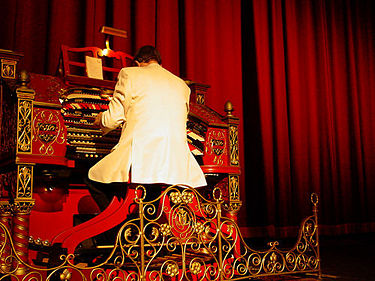Mighty Wurlitzer Theatre Organ
The Mighty Wurlitzer Theatre Organ, also called Big Bertha, is a historic restored 32-rank pipe organ at the Alabama Theatre. It occupies three original organ chambers flanking the auditorium's stage and screen, and has been expanded with additional ranks mounted above the ceiling.
The original instrument was a 4-manual, 20-rank Crawford Special-Publix One theatre organ made by the Rudolph Wurlitzer Company of North Tonawanda, New York to the specifications of Jesse Crawford, then the organist of the flagship Paramount Theater in New York City. Dubbed "Opus 1783", it was one of 17 such instruments commissioned by Paramount for its theaters across the United States. Of those, the Alabama's is only one of three to survive in its original location. The other two are in Denver, Colorado and Seattle, Washington.
The organ's unique brilliant red and gold painted console and seat were specially designed by Wurlitzer to match the Hispano-Moresque interior decor of the Alabama Theater. They are mounted together on a screw lift made with an axle and parts from a Ford pickup truck. The lift allows the console to be raised to stage level or lowered, out of sight, to the orchestra floor.
Since its original installation, the organ was expanded to 32 ranks and has seen the addition of multiple percussive and other mechanical special effects such as thunder, whistles, horse hoofs and sleigh bells. The original Howard seat was also replaced with a larger bench.
The organ was used to perform musical overtures and accompaniment to silent films as well as for special music concerts and occasional weddings and church services held at the theater. The presentation of silent films was largely eclipsed by "talkies" in 1929, but the organ continued to be used for overtures at the start of each program. Beginning in 1931 a special program of organ music performed by Della Dean Orr was broadcast from the Alabama Theatre each weekday morning and Sunday evening on WKBC-AM. Orr had been fired from the Temple Theatre and, according to rumors reported by Lee Erwin, was so inexpert a player that the Alabama's management threatened to deny WKBC access to the Wurlitzer if she were not replaced with a better organist.
After long-time organist Stanleigh Malotte retired in 1956 the organ was less-often used. Charlie Cox, who coined the instrument's "Big Bertha" nickname, played for weekly "Ladies Shopper Matinee" screenings on Wednesdays through the Summer of 1964.
Later that same year, member of the Southeastern Chapter of the American Theatre Organ Society began efforts to restore the worn-down organ. Organist Jay Mitchell participated in those efforts and helped establish the local Alabama Chapter of the American Theatre Organ Society in 1973. That group continues to maintain the instrument under the guidance of crew chief Larry Donaldson.
In 1988 the organ's original Wurlitzer relay was replaced with a computer-based action which also allows playback. An additional 7.5 horsepower blower was also installed ahead of the original 10 horsepower blower to increase the capacity of the instrument. In 1992 the console was modernized and made portable so that it could be moved aside for opera and ballet performances on the theater's stage. In 1998 another series of repairs and upgrades were made to the console, including the final phase of its repainting.
Ranks
|
|
Organists
- Joe Alexander, December 26, 1927-September 17, 1928
- Lillian Truss, January 28, 1928-March 4, 1929
- Lee Erwin, March 4-April 29, 1929
- Edwin Lyles Taylor, October 26-December 7, 1931
- Gladys Lyle, June 6-October 24, 1932
- Malcolm Tate, October 24-December 19, 1932
- Randy Sauls, December 19, 1932-June 10, 1935
- Jessie Walker, June 10, 1935-March 5, 1937
- Carl Hinnart, March 19, 1937-April 30, 1937
- Ray Sellers, April 30-May 27, 1937
- Stanleigh Malotte, May 27, 1937-December 26, 1952 and July 23, 1954 -September 14, 1956
- Charlie Cox, February 28-July 17, 1964
- Jay Mitchell, April 19-August 6, 1971 and February 25-December 22, 1972
- Bernard Franklin, 1972-1976
- Cecil Whitmire, 1976-April 25, 2009
- Gary Jones, April 25-2009-present
References
- "WKBC Studio Hostess Has Wide Experience in Organ Broadcasts" (March 8, 1931) The Birmingham News, p. 12
- Liles, Dan (n. d.) "Birmingham, Alabama Theatre Organ History". Alabama Chapter of the American Theatre Organ Society
- Donaldson, Larry (n. d.) "The Alabama Wurlitzer". Alabama Chapter of the American Theatre Organ Society
- Erwin, Lee Orville (2012) An American Organist in Paris: The Letters of Lee Orville Erwin, 1930-1931. Michael Hix, editor. Lanham, Maryland: Scarecrow Press ISBN 0810883384
- Brock, Glenny (2015) Alabama Theatre: The Showplace of the South. Birmingham: Birmingham Landmarks, Inc. ISBN 9780996253550
External links
- The Wurlitzer at the Alabama Chapter of the American Theatre Organ Society's website

